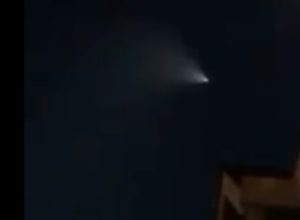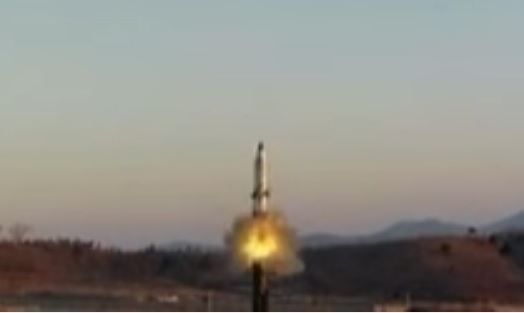NORTH KOREA’S INTERCONTINENTAL FEBRUARY SURPRISE?
NASPNet Blue Peter
February 16, 2017
by Peter Hayes, Honorary Professor, Center for International Security Studies, Sydney University, and Director, Nautilus Institute.
I. INTRODUCTION
Peter Hayes writes that the missile tested on February 12 2017 was not an intercontinental missile. Rather it was most likely a land-based version of the same missile fired previously from a submarine. If deployed and fired at sea at the ROK, it would overwhelm THAAD missile defenses in Korea. Although it was not a February intercontinental surprise, the DPRK is deliberately gaining missile capability unless the United States and its partners address its security concerns and reverse its trajectory toward full-scale nuclear armament with all the risks of loss of control and inadvertent war resulting from this outcome.
A short version of this essay was published here by The Conversation.
Acknowledgment: This report was funded by MacArthur Foundation.
Banner image: from North Korean news video
Note: This text was amended slightly on February 17, 2016 PST.
II. NAPSNET BLUE PETER
NORTH KOREA’S FEBRUARY INTERCONTINENTAL SURPRISE?
February 16, 2017
by Peter Hayes
On January 1 2017, Kim Jong Un stated that in 2016,
We conducted the first H-bomb test, test-firing of various means of strike and nuclear warhead test successfully to cope with the imperialists’ nuclear war threats, which were growing more wicked day by day, briskly developed state-of-the-art military hardware, and entered the final stage of preparation for the test launch of intercontinental ballistic missile; we achieved other marvellous successes one after another for the consolidation of the defence capability.
What Kim Jong Un meant by “intercontinental” of course is anyone’s guess. Presumably “inter” means some other continent than the Eurasian continent, assuming such a missile is fired from land in North Korea.
Amongst missileers, an intercontinental ballistic missile is one that has multiple stages, often more than one warhead-containing re-entry vehicles, and travels at least 5100 km away from its firing point (although it travels much further through space). This definition was codified into the Intermediate Nuclear Forces treaty between the former Soviet Union now Russia, and the United States which defined “intermediate” as a missile with range between 1000–5500 km, meaning anything with greater range than 5500 km is considered conventionally to be “long range.”
A North Korean missile could reach parts of Alaska and the Aleutians, the nearest continent to North Korea, in between ~5100-4900 km, that is, in less than 5500 km, so Kim wasn’t setting a bar too high with his statement.
The very next day, US President Trump tweeted that “North Korea just stated that it is in the final stages of developing a nuclear weapon capable of reaching parts of the U.S. It won’t happen!” This tweet was dismissed as more bloviating by Trump because unless he either attacks the launch site risking a catastrophic war or engages massively with the DPRK, also incredible, he has no way to stop such a test-firing.
Not long after (January 11, 2017), US Pacific Command announced that it was sending a ship-based radar to a location about 2300 km northwest of Hawaii. Because a missile fired to the south (as with past North Korean space rocket launches) would not be picked up by this radar, specialists speculated that PACOM might have learned that the DPRK might be planning to fire a long-range missile over the top of first Japan and then Hawaii, and have it re-enter into the southwest Pacific ocean. This was viewed as barely credible, however, because to date, the DPRK has not demonstrated anything resembling such a long-range missile capability.
So what exactly is the significance of the DPRK’s February 12 missile test? Was it “intercontinental?” Was it new? Was it something to worry about?
The most recent test was new. It was a land-based launching from a TEL using solid propellant. Past North Korean missile firings in this range were liquid fueled, which takes many hours to prepare. This missile seems to have taken the solid propellant developed for its KN-11 submarine launched missile, tested twice to date, and applied it to a land-fired missile. Specialists who have reviewed North Korea’s official video of the latest launch—including Kim Jong Un’s on-the-spot guidance!—observed that the base diameter of the missile is about 1.4 meters—the same as the KN-11. Other than a slightly shorter warhead, the missile appears identical to the KN-11 although the DPRK called it a new missile and named it the Pukguksong-2.
The missile was launched more or less vertically from far northwestern DPRK in what is called a “lofted trajectory” and splashed down in the coastal waters east of North Korea (making it hard for US or allied navies to retrieve the parts). It was a two stage missile. The first stage burned for about one minute, the second stage for half a minute. It was launched out of the tube by high pressure cold gas and then the missile ignited. It reached about 500+ km peak altitude, and achieved about 500 km range.
Fired in anger, and fully developed, it might have a range of roughly 1000-1200 km when carrying a nuclear warhead and fired with a normal rather than a lofted trajectory—far short of a Kim’s January “intercontinental” missile range—but far enough to hit Japan, South Korea, China, and Russia, as well as anything on the oceans that surround South Korea.
For those interested in the arcanery of North Korean missiles, there being too many for most people to keep in their head at the same time, they should read the overview by missile experts Ted Postol and Markus Schilling in the most recent issue of the scholarly journal Korea Observer.
What’s important to know is that the successful application of the KN-11 propellant in a land-based missile would enable the DPRK to field a far more credible and operational mobile land-based missile force that could move around and hide in caves, then “pop-up” to fire when ordered. One test does not mean such a force can be fielded with confidence that it is reliable. Missile powers like the United States conduct scores of development tests before they field a missile. Nonetheless, the missile did not blow up on the ground or in the air, as with many past North Korean missile tests. Presumably they learn something with each test.
Equally or even more important is that the submarine version is also likely to be tested again soon. When it is fielded—and North Korea is reportedly near completing a diesel missile firing submarine—then it will be able to deploy missiles in the West Sea of Korea, known to most people as the Yellow Sea. This part of the ocean is shallow and very difficult to track submarines due to its poor and confused acoustics. Once this force is ready to put to sea, then Kim Jong Un will have simply gone around American anti-ballistic missiles that are to be deployed soon in South Korea, because these are not capable of tracking missiles coming from offshore. As Ted Postol wrote to me after the test:
Submarine launched ballistic missiles with a range of 1000 to 1200 km would require missile defenses to have 360° azimuth search and defense capacity. Because the THAAD radar can cover a search azimuth of about 106°, this would mean three additional THAAD radars would be required to give South Korea missile defense radar detection and tracking that must be used by THAAD interceptors. Each of these radars are about $200 million each. In addition, interceptors would have to be placed relatively near coastal installations that are to be defended. Unless interceptors are placed near locations to be defended, they will often be too far from the defended asset to reach it in a timely manner ahead of attacking missiles.
Proceeding with submarine launched missiles will entail a risk for Kim Jong Un and everyone else, however. Currently, one assumes that Kim maintains very tight procedural positive and negative controls on his nuclear weapons. Positive measures (such as alert levels) ensure that if he decides to fire them, then once authorized, the weapons will be fired. Negative controls (such as a two person launch rule using authenticated codes) ensure that no-one else can fire them. In the DPRK, these likely veer towards extremely centralized and personalized control, dominated by the military. There are also positive and negative technical controls (such as redundant communications to transmit fire orders and permissive action links); but these are likely to be quite weak in North Korea as they are expensive and often relatively high technology.
While on land,procedural controls can be sustained relatively straightforwardedly. But once nuclear weapons are put to sea on a submarine that will be hunted mercilessly by enemies, Kim will have to pre-delegate use authority in extremis to commanders of the submarines or risk their capture and destruction if he retains control and insists on communicating with submarines at sea, thereby putting them at risk. This presents Kim with an exquisite dilemma—one that is actually shared by those who want to “decapitate” the North’s leadership in a war and who would then face the prospect of nuclear attack by North Korean submariners intent on revenge attacks.
How long will it take for the North to develop and deploy medium-range land based and submarine-based solid propellant missiles able to hit anywhere in South Korea (or aircraft carrier battle groups sailing offshore)? No-one knows, but a reasonable guess is three to five years or longer.
And, where did the DPRK obtain the expertise and materials for solid propellants? There are only two candidates given the sanctions regimes. These are China and Russia. Of the two, Russia is the most likely as this is also the most likely source of much of the North Korean rocket engines now reverse engineered and redesigned by North Korean missile engineers.
This may have been Kim’s February surprise for Mr. Trump, maybe not. But it certainly demonstrates that he has an immense amount of work to do to reverse North Korea’s nuclear breakout. Issuing mild rebukes alongside Mr. Abe at his Mar A-Lago golf course won’t do the trick.
So was this the intercontinental missile Kim Jong Un mentioned on January 1st as coming soon? It appears not, so Pacific Command may have reason soon to redeploy that radar ship if they haven’t already.
Of course, media pundits and purveyors of fake news alike have not mentioned that the North Korean test was bracketed by American missile tests.
On February 8th, three days before the North Korean test on February 12th, the United States fired a Minuteman 3 missile from Vandenburg California to Kwajalein Atoll in the Western Pacific, 6700 km away (although this is only about half its maximum range when loaded with a single W87 thermonuclear warhead which detonates with about one third to one half a million tonnes of TNT equivalent). This was the same type of test that the United States delayed in April 2013 because it might be misinterpreted as an attack on North Korea. The missile breaking through cloud shortly after liftoff is shown below.

On February 14th, two days after the North Korean test, the United States fired a US Trident missile test from a submarine offshore Vandenburg to the same test site, shown below as seen from San Francisco.

Many Americans saw these launches in their night sky. Rather than worrying about North Korean nuclear attack or celebrating the awesome spectacle of American nuclear might in flight (sans warheads), a lot of them wondered if these were UFOs arriving on Earth–as occurred when a 2015 Trident test erupted into daily life above Los Angeles. That’s likely not how the North Koreans saw them while monitoring American social media for signs of pending nuclear attack, as they surely do.
This is not to suggest that Kim’s February 12 test was a response to the fear that one of these tests was a sneak attack on him. More likely, Kim’s test was timed to coincide with the Trump-Abe meeting.
Of course, unlike the North Korean missiles which have been declared illegal by the UN Security Council, there’s nothing illegal about American missile tests. Consistency in such matters is apparently a hobgoblin in the minds of small powers. Readers can make up their own mind on that score.
III. NAUTILUS INVITES YOUR RESPONSES
The Nautilus Peace and Security Network invites your responses to this report. Please send responses to: nautilus@nautilus.org. Responses will be considered for redistribution to the network only if they include the author’s name, affiliation, and explicit consent.


